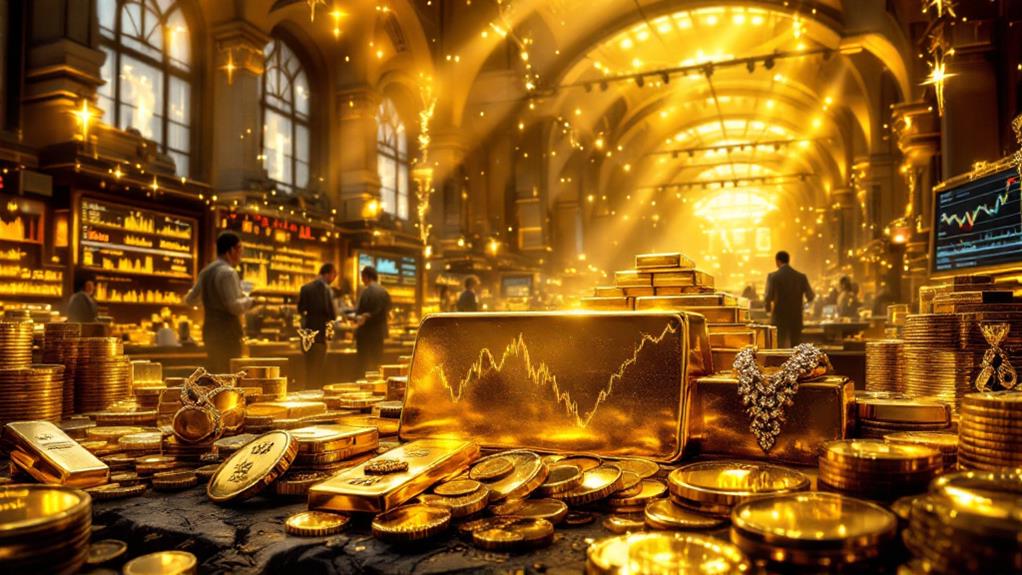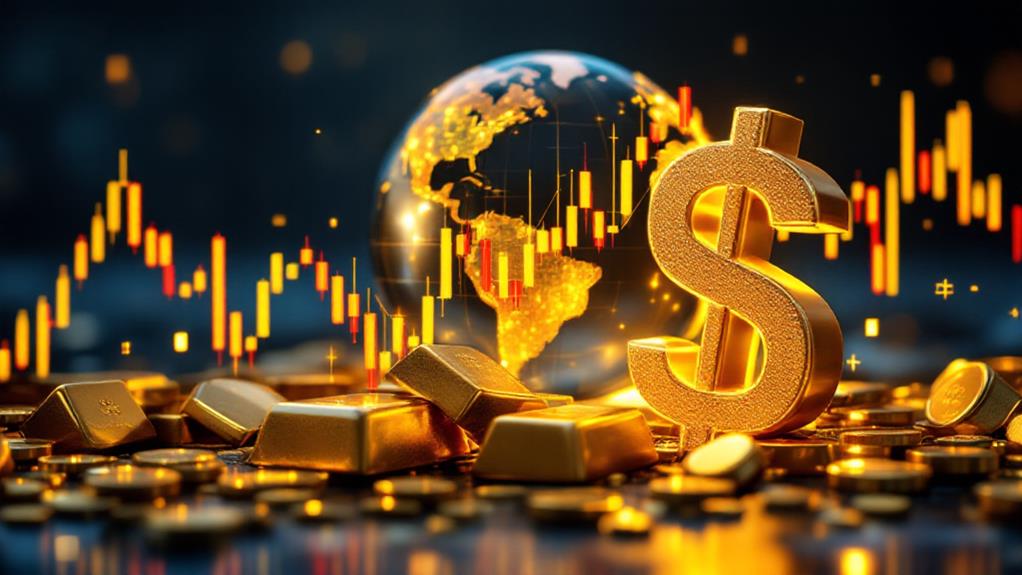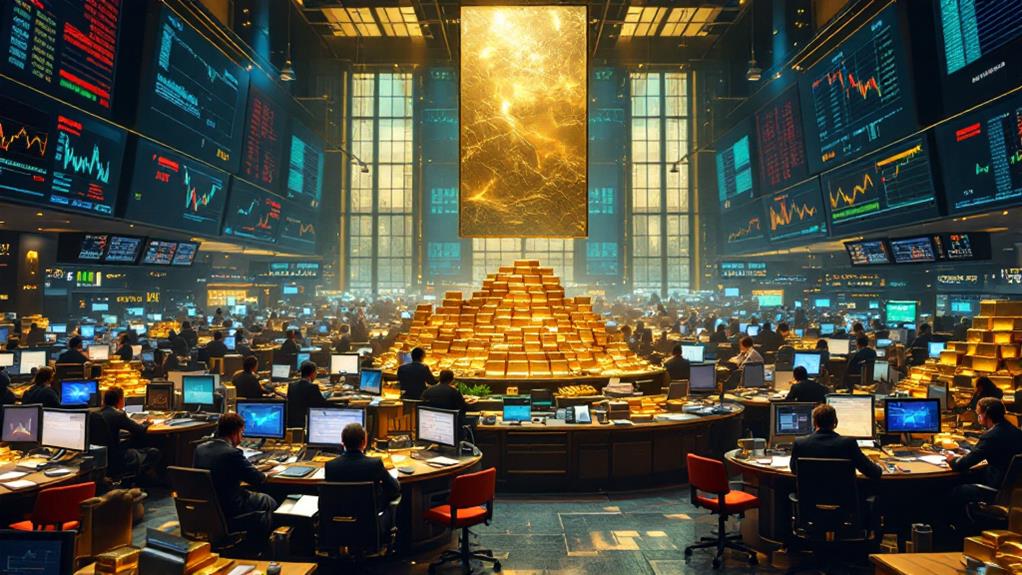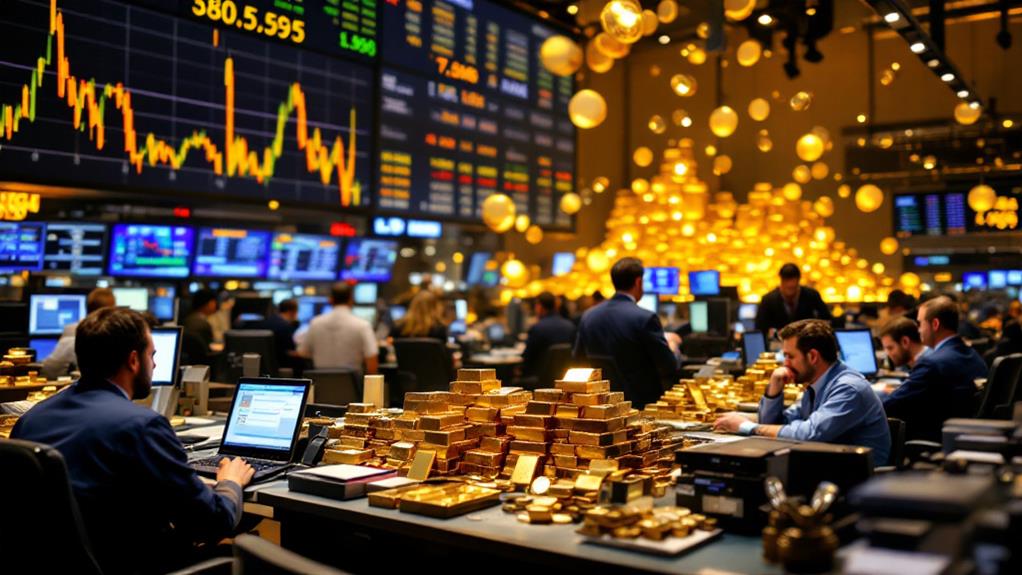How the Price of Gold and Precious Metals Is Set

The price of gold and precious metals is set through different factors like economic indicators, supply and demand, and the influence of the U.S. dollar. Strong economic data can lower demand as gold is less attractive when interest rates rise. Geopolitical tensions and market sentiment often enhance demand, as people seek safety. The U.S. dollar's strength also plays a role, with a weaker dollar making gold more appealing. Commodity exchanges conduct price revelations through futures contracts and spot prices, guiding market participants. Understanding these elements gives you a glimpse into how prices are determined, sparking curiosity about the intricate details.
Economic Indicators Impacting Prices
Economic indicators play a vital role in determining gold prices. You might wonder how these indicators influence the demand for gold. Consider the monthly jobs report and wage data; they're fundamental. Strong employment figures usually suggest a healthy economy, leading to a reduced demand for gold, as it's less needed as a safe-haven asset. When employment is robust, people feel financially secure, and the allure of gold diminishes.
GDP growth rates are another significant factor. When you see robust economic growth, it often results in higher interest rates. This scenario can make gold less appealing as an investment because investors might prefer assets that offer better returns. However, when inflation rates rise, you'll notice a different trend. Investors flock to gold as a hedge against inflation, driving up gold prices since it protects against currency devaluation.
Stock market volatility is also noteworthy. During turbulent times, you might notice increased demand for gold. Investors seek the stability gold offers amidst economic uncertainty. Ultimately, keep an eye on the Federal Reserve's policies. When interest rates are low, gold prices generally increase, as the cost of holding gold decreases, enhancing its demand.
Supply and Demand Dynamics
When you think about the forces driving gold prices, supply and demand dynamics take center stage. The price of gold and other precious metals spot is primarily driven by this delicate balance. As demand for gold increases, especially with limited supply, prices tend to rise. This is evident when global mining production levels fall short, often due to limited new findings, leading to supply constraints.
For silver, the demand is heavily influenced by its industrial applications, especially in electronics and medical fields. Technological advancements can cause sudden surges in silver pricing, further demonstrating the impact of supply and demand dynamics. Central banks also play a significant role by purchasing gold, which can affect availability and, subsequently, the price of gold.
Additionally, consumer demand for gold in jewelry and electronics continues to shape the market. Geopolitical events often increase gold and silver's appeal as safe-haven assets, driving up demand and impacting prices amid fluctuating supply conditions. Understanding these dynamics helps you grasp why the price of gold and precious metals spot can be so volatile, influenced by both tangible supply factors and shifting market sentiments.
Influence of the U.S. Dollar

While supply and demand dynamics are fundamental to gold pricing, the influence of the U.S. dollar is equally significant. Gold prices are quoted in U.S. dollars, meaning any fluctuation in the dollar's value can directly impact the market price of gold. When the U.S. dollar strengthens, gold tends to become more expensive for investors using other currencies. This shift often leads to decreased demand and lower gold prices, as international buyers find it harder to afford the metal.
Conversely, a weaker U.S. dollar makes gold more attractive. When the dollar loses value, gold prices generally rise because the metal becomes a more enticing hedge against currency depreciation. This relationship is evident in historical data, which shows an inverse correlation between the U.S. dollar index and gold prices. When the dollar drops, investors often turn to gold, pushing its market price upward.
Currency exchange rates also play an essential role in this dynamic. As the U.S. dollar fluctuates against other currencies, it affects international trade and investment in gold and silver. Understanding these interactions can help you make informed decisions about when to invest in precious metals.
Geopolitical and Market Sentiment
Steering through the complex world of gold pricing often involves understanding the significant impact of geopolitical and market sentiment. When geopolitical tensions rise—be it due to conflicts, sanctions, or political instability—investors often flock to gold as a safe-haven asset. This rush to safety drives up gold prices, as seen historically during times of economic uncertainty. You might notice how media coverage and public perception of these geopolitical events can sway market confidence, leading to rapid changes in trading behaviors and metal prices.
Market sentiment also plays an essential role in influencing gold prices. If investors feel positive about the market's future, you might see them selling off gold in favor of riskier assets, causing a dip in prices. Conversely, negative sentiment or fears of economic downturns can trigger a buying spree, pushing prices up as investors seek security in tangible assets like gold. Furthermore, central banks often respond to geopolitical risks by purchasing more gold, further impacting the market dynamics. These purchases not only increase demand but can also alter supply levels, contributing another layer of complexity to the ever-fluctuating landscape of gold pricing.
Technological Advances in Mining

Technological advances in mining have transformed the industry by considerably improving efficiency and reducing costs. You're witnessing a shift where automation and robotics play vital roles in increasing production. These technologies cut down labor costs, allowing miners to extract more gold and silver, ultimately impacting the gold market. Innovations like hydraulic fracturing and advanced geological modeling let miners access deposits that were once out of reach, enhancing the supply of precious metals.
Data analytics and artificial intelligence are now integral parts of mining operations. They help make informed decisions by optimizing resource allocation, thereby increasing the reliability of extraction processes. This optimization reduces environmental impact, making it easier for you to trust these methods as reliable sources of precious metals.
Moreover, improved recycling techniques are enhancing the availability of precious metals. By using sophisticated separation technologies, old jewelry and electronic waste can be processed efficiently, adding to the supply chain. Environmentally friendly methods like bioleaching also aim to minimize the ecological footprint of mining. As these technologies advance, they influence precious metals futures, affecting how you perceive investment opportunities in this sector.
Understanding Spot Price
Spot price is the immediate price at which gold and other precious metals can be purchased, directly reflecting real-time market dynamics of supply and demand. It's measured in troy ounces, which are about 10% heavier than standard ounces, ensuring you're aware of the true weight in precious metal transactions. The spot price acts as a snapshot of the market's current state, showcasing what buyers are willing to pay and sellers are ready to accept.
This equilibrium is vital, as it's influenced by numerous factors, including economic indicators and market volatility. Spot prices can change rapidly, making it critical to stay informed if you're considering buying or selling. Though the spot price is a baseline, when you buy metals, expect to pay above it due to premiums. These premiums account for costs like mining, refining, and distribution, ensuring the metal's passage from the mine to your hands.
Futures Contracts and Their Role

Building on the foundation of the spot price, futures contracts play an important role in the gold market by allowing you to hedge against potential price changes. When you enter into a futures contract, you're agreeing to buy or sell a specified quantity of gold at a predetermined price on a future date. This agreement lets you lock in prices and manage the risk of price fluctuations, which can be vital for both investors and businesses reliant on precious metals.
Most futures contracts for gold, especially those traded on exchanges like COMEX, are settled in cash rather than through the physical delivery of metals. Over 90% of these trades don't result in the actual transfer of gold, highlighting their function as financial instruments rather than a means to physically acquire the metal. The futures prices are shaped by factors such as market sentiment, economic data, and geopolitical events, which can cause significant volatility.
Commodity Exchanges and Trading
When you investigate the world of commodity exchanges and trading, you'll find that they play a crucial role in the gold market. Commodity exchanges like COMEX and the London Bullion Market Association (LBMA) are fundamental platforms where futures contracts for gold and other precious metals are traded. These exchanges facilitate price revelation through active market transactions, giving you a clear picture of how gold values shift. Because trading occurs around the clock, the exchanges provide continuous price updates, reflecting real-time supply and demand.
You'll notice that over 90% of futures contracts on COMEX don't result in physical delivery. Instead, they highlight the speculative nature of financial trading in the precious metals sector. The spot price of gold, which indicates current market conditions, is derived from these futures contracts' prices. This spot price isn't about immediate delivery but rather a snapshot of gold's market value at any given moment.
Major commodity exchanges utilize electronic auction systems to guarantee transparency and accessibility. These systems let participants swiftly react to news or events that could impact the market. As a result, you can always have up-to-date information crucial for making informed trading decisions.
Spot Price Impact on Physical Metals

The spot price is a crucial benchmark in the precious metals market, shaping how prices are set throughout the supply chain. It influences every step, from the initial extraction of ore to the ultimate sale of coins and bars. As a buyer or investor in physical metals, understanding how the spot price impacts what you pay is vital. Miners typically sell ore to refiners at prices slightly below the spot price. This strategy helps them stay competitive while covering their production costs. When refiners process the ore into bullion, they sell it to mints at prices just above the spot price, reflecting their refining and processing expenses.
Mints then turn this bullion into coins and bars, offering them at prices marginally higher than what they paid refiners. This increment accounts for their production and distribution costs. Ultimately, dealers like JM Bullion sell these finished products at prices above the spot price. This markup guarantees profitability, covering handling, storage, and sales costs. So, when you buy physical metals, the spot price is your starting point, but the ultimate price reflects a series of necessary markups throughout the supply chain. Understanding these layers helps you make informed buying decisions.
Key Players in Price Setting
At the heart of gold pricing, several key players exert significant influence. Large banks, bullion traders, and market-making firms are instrumental in shaping the price of gold through their trading activities. Among these, the London Bullion Market Association (LBMA) holds a significant role by setting the global benchmark for gold prices. They conduct daily auctions involving major banks and financial institutions to determine the LBMA Gold Price, which serves as a essential reference point for the market.
Futures markets, like COMEX, are also important in price setting. These exchanges offer a platform where contracts are traded based on market expectations for future gold prices. By doing so, they reflect sentiment and potential shifts in supply and demand, impacting current price levels.
Central banks can't be overlooked either. Their decisions to buy or sell gold can dramatically alter the supply-demand balance, influencing prices. Furthermore, mining companies, recyclers, and consumers all play their part in the pricing mechanism. Each of these participants impacts the gold market, regardless of the introduction of new supply, recycling efforts, or purchasing activities, collectively shaping how gold's value is determined globally.




